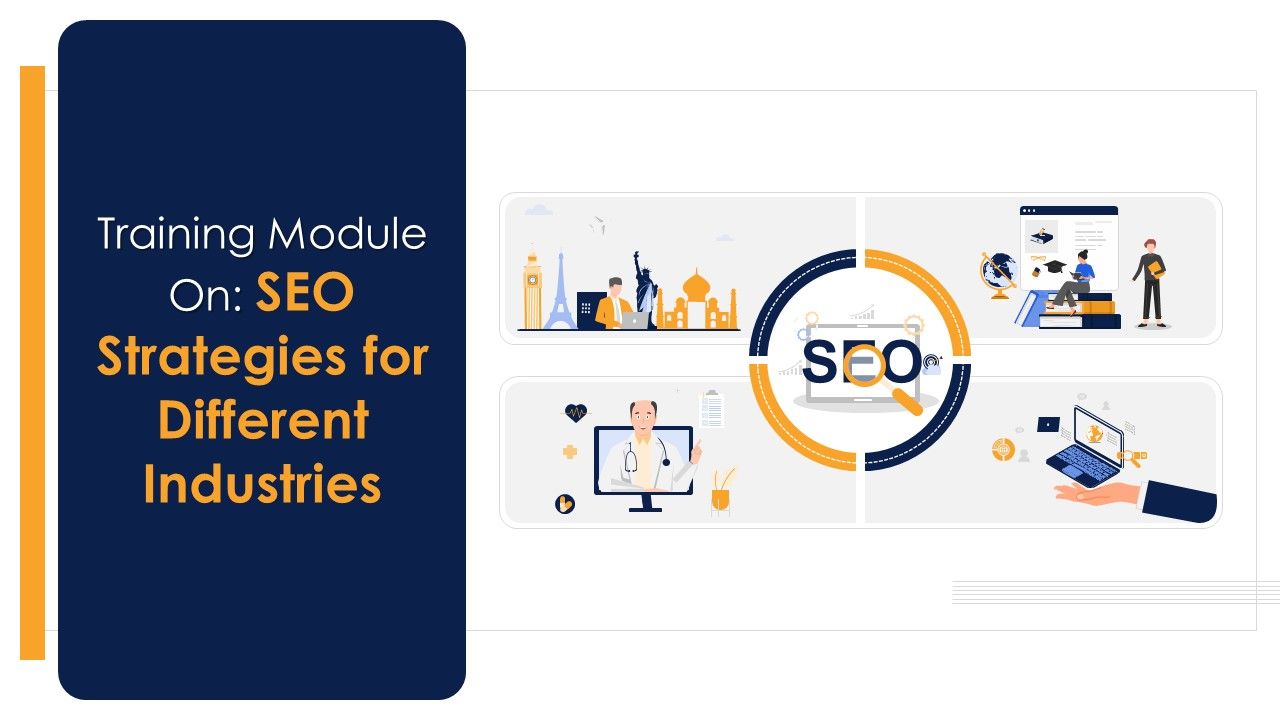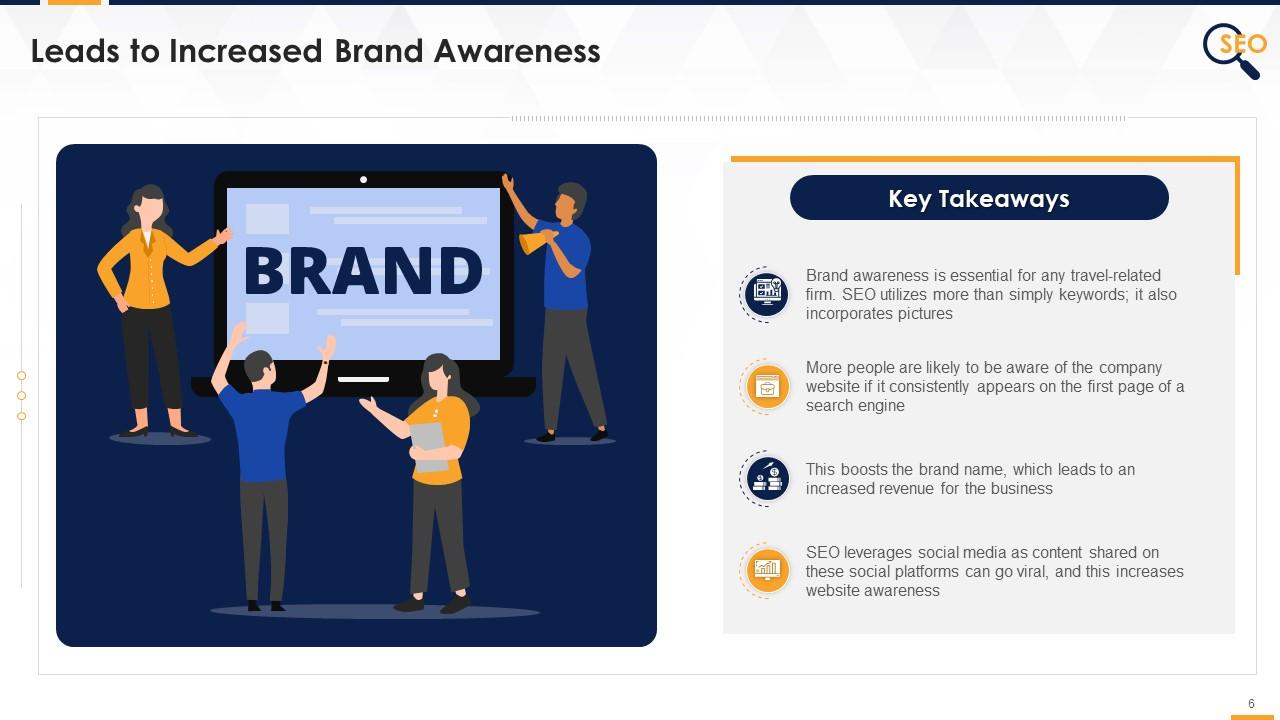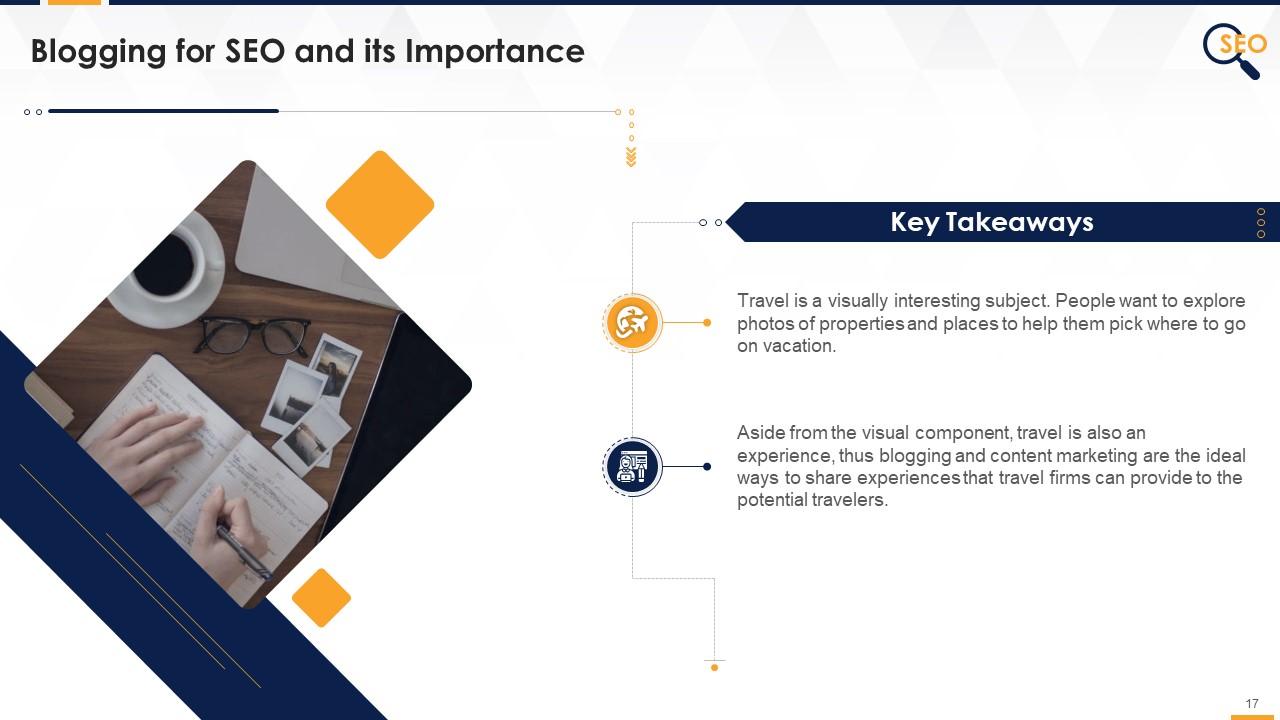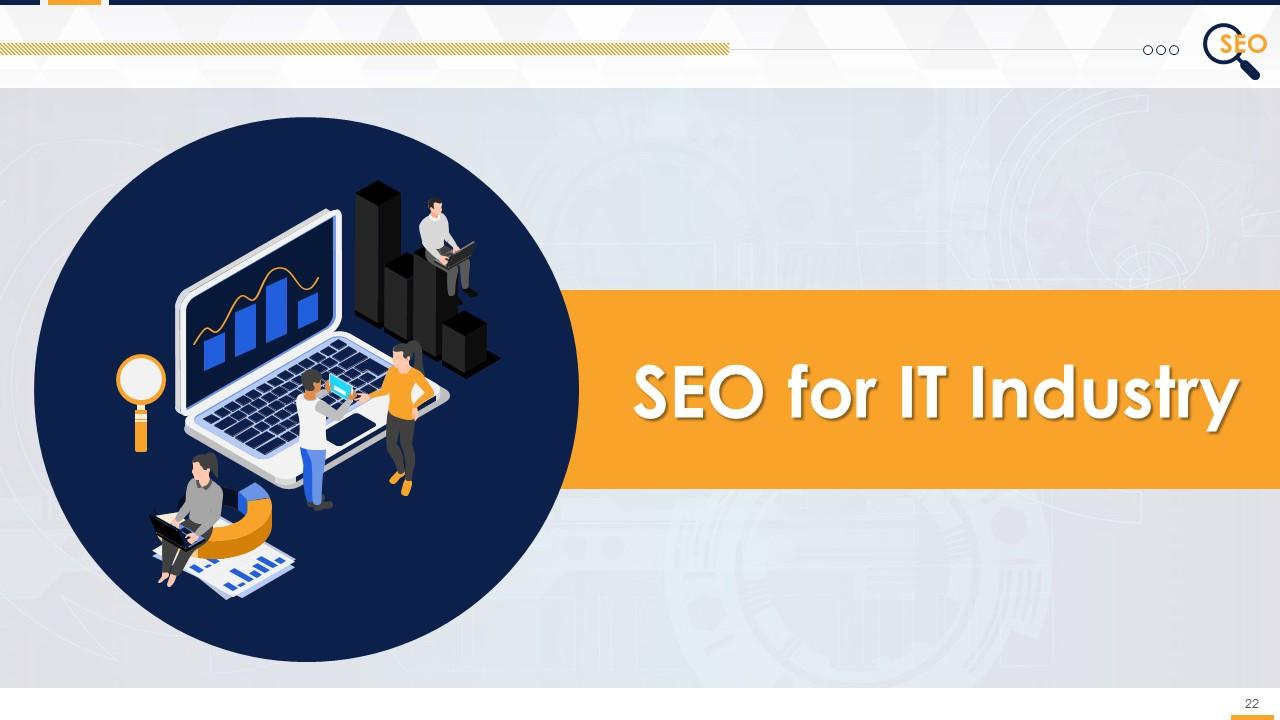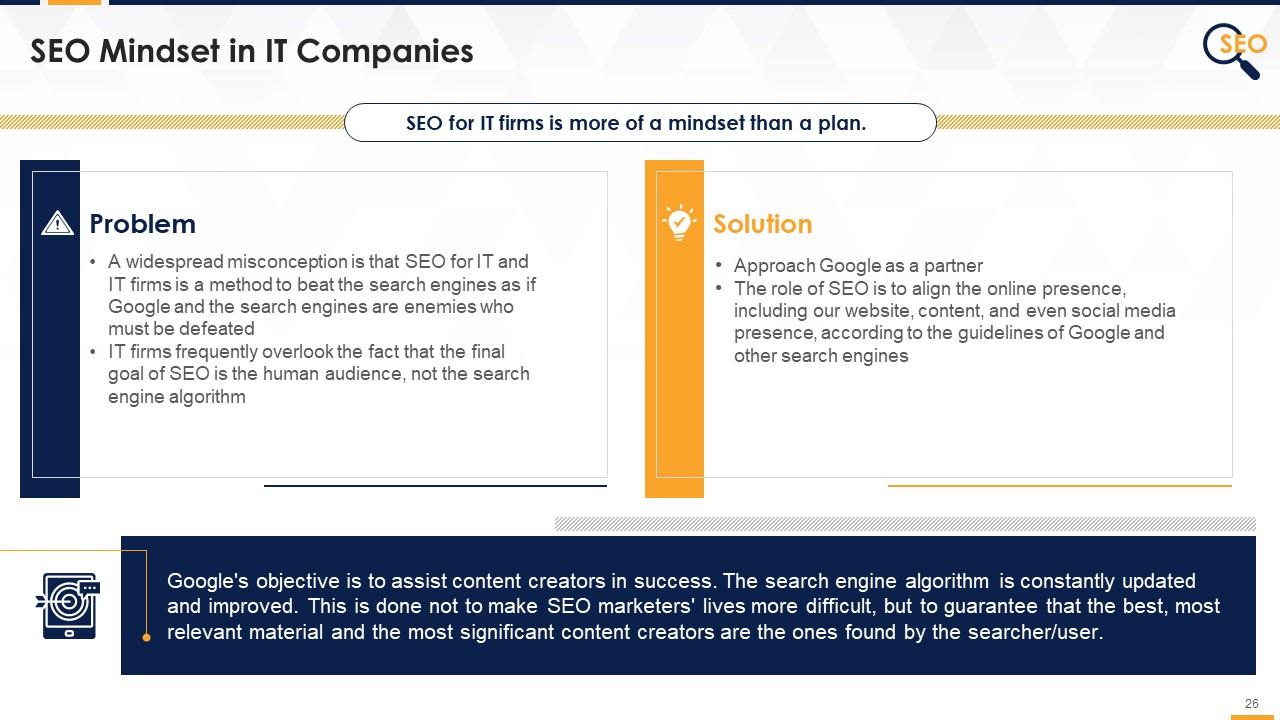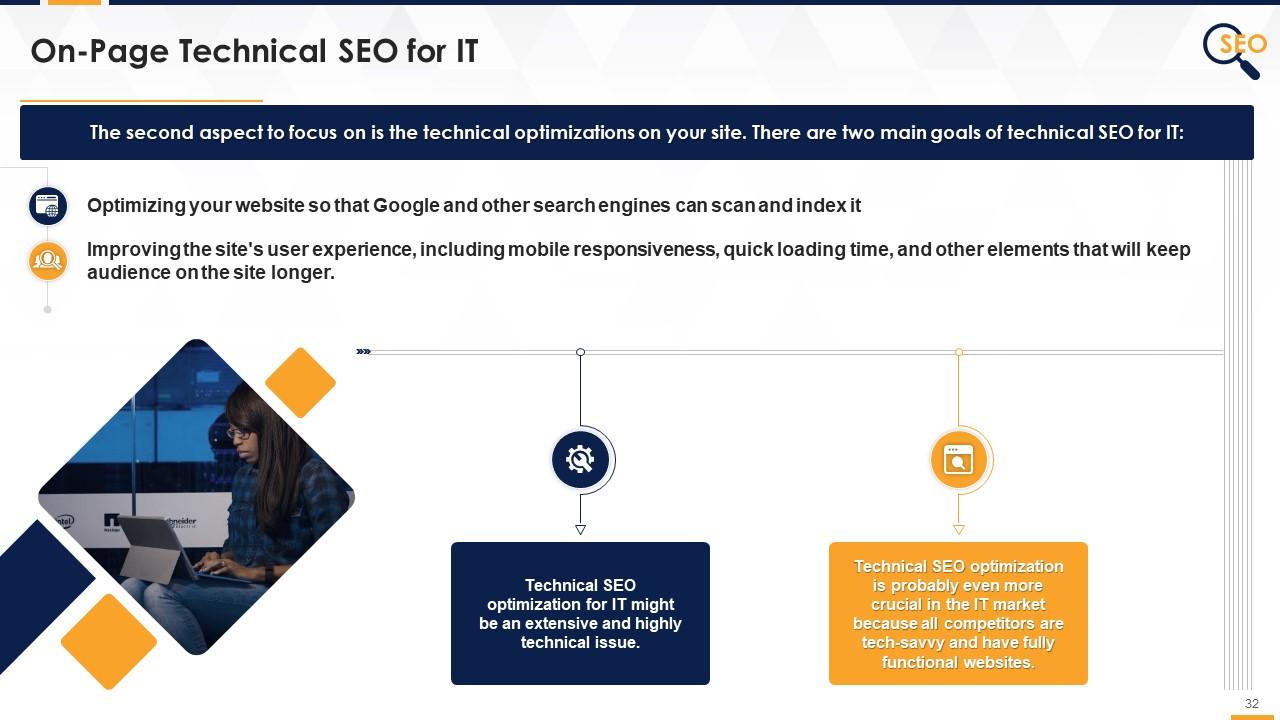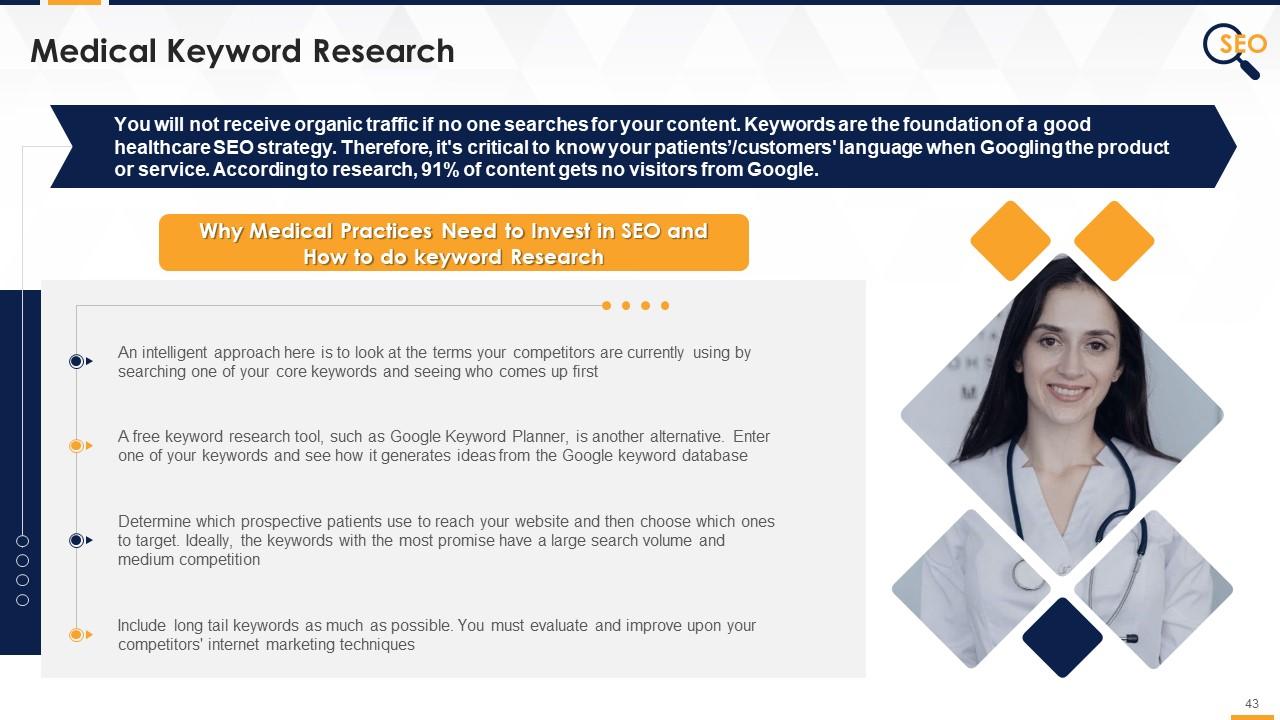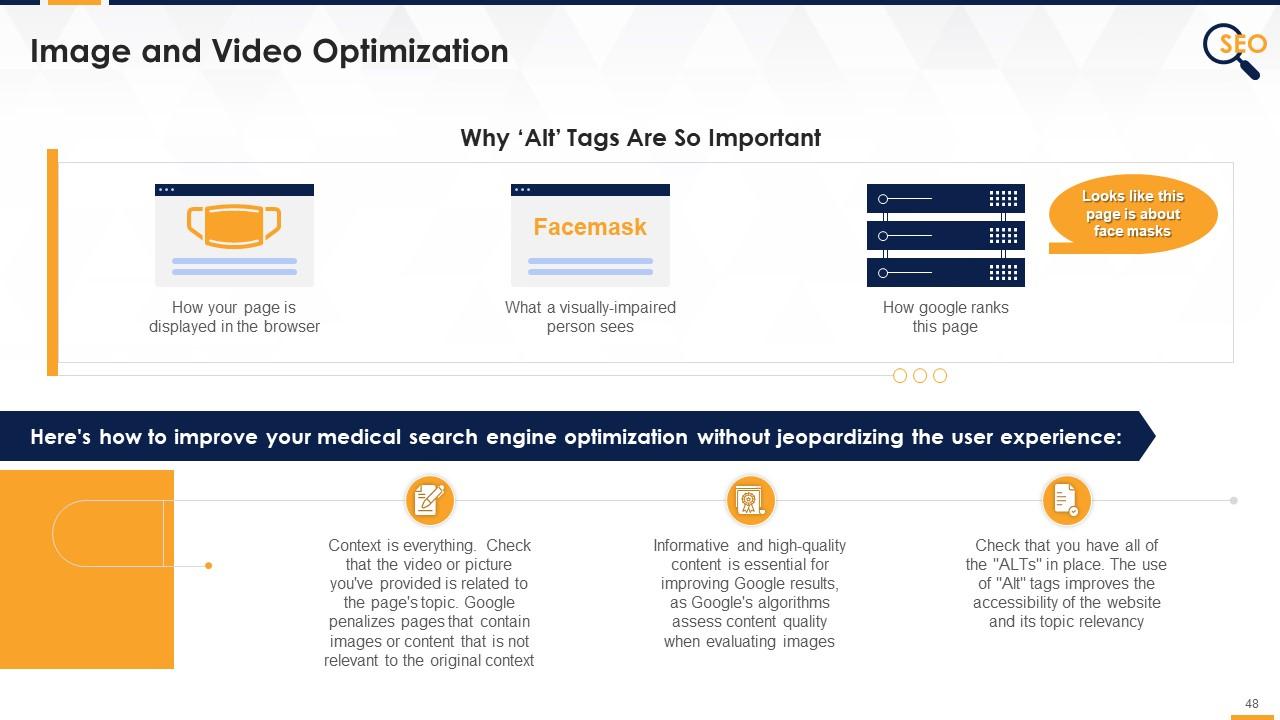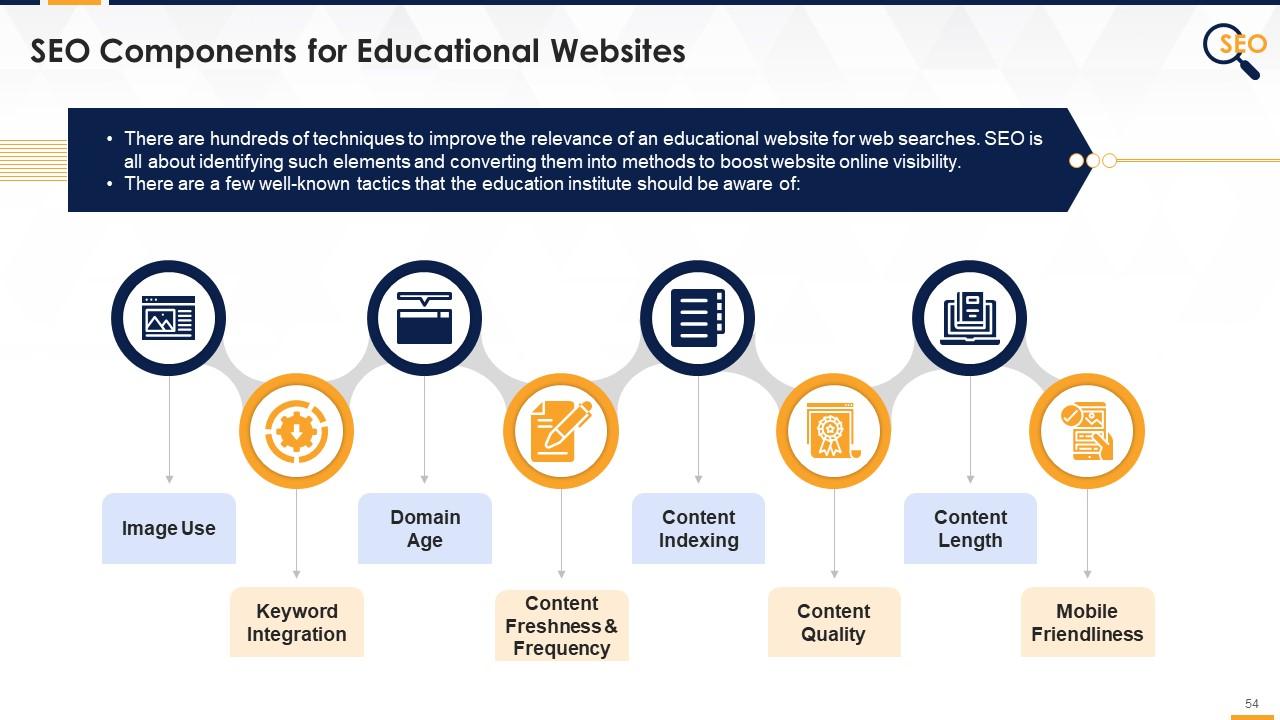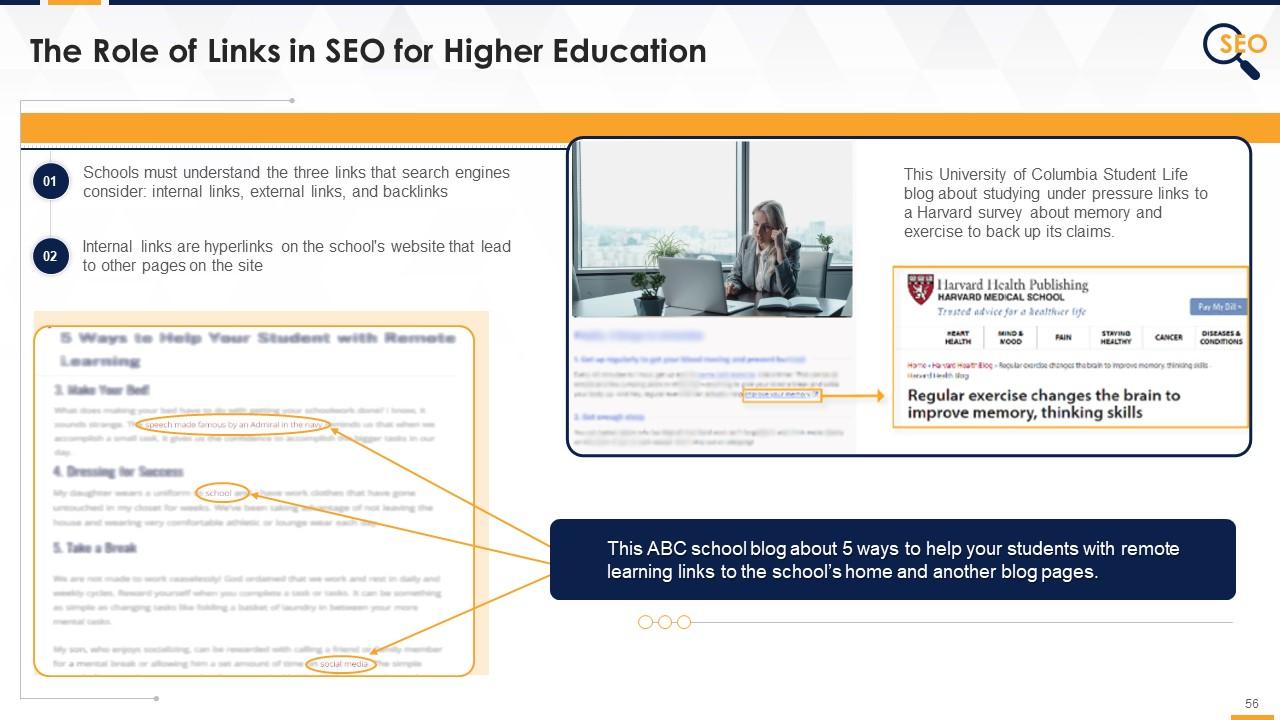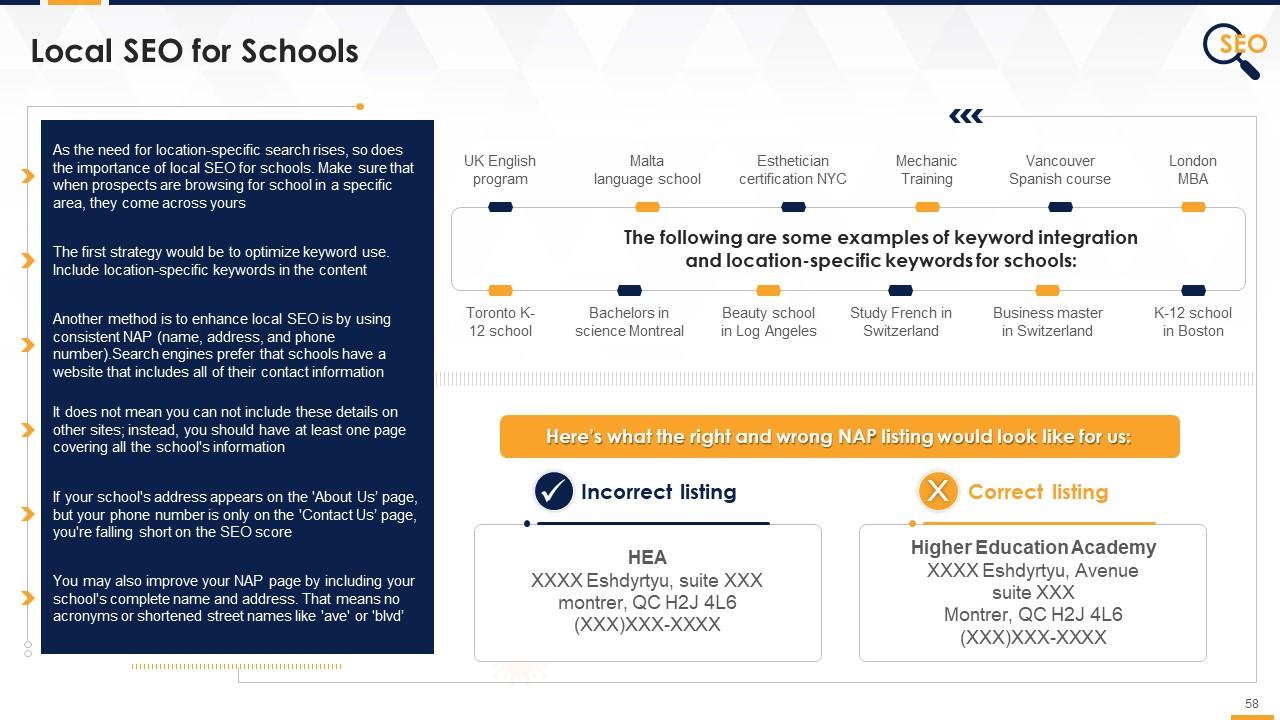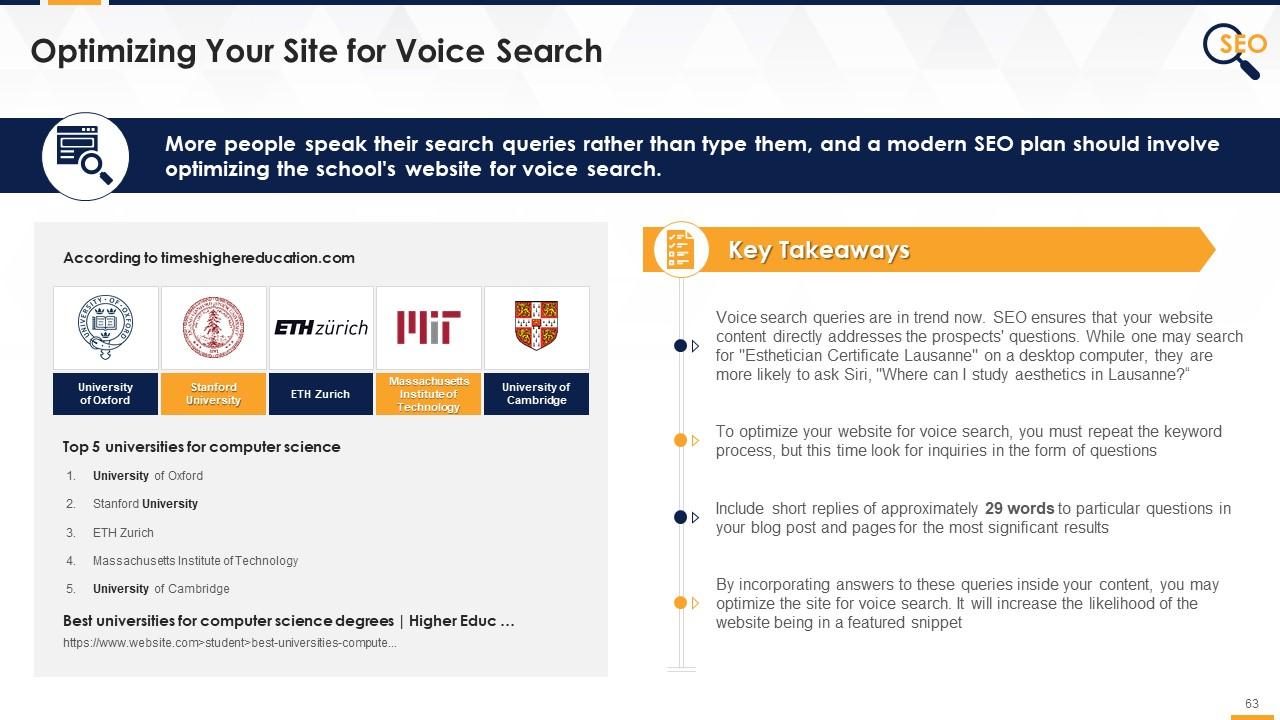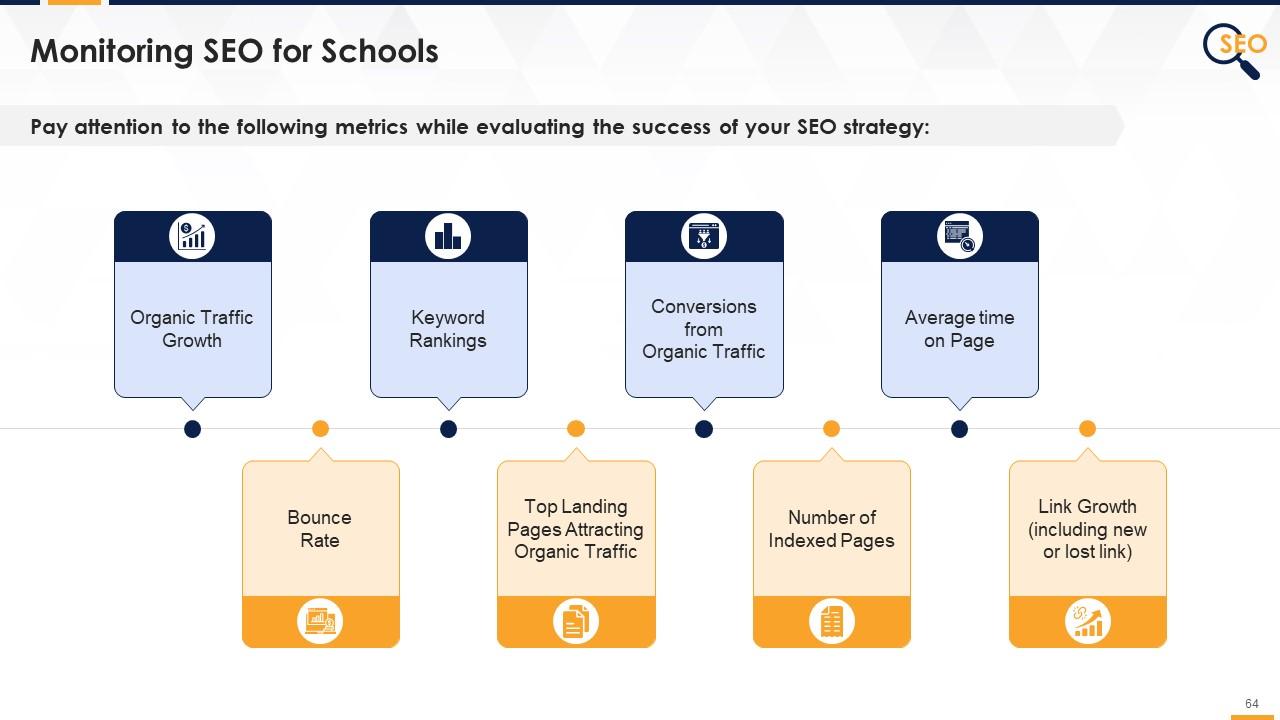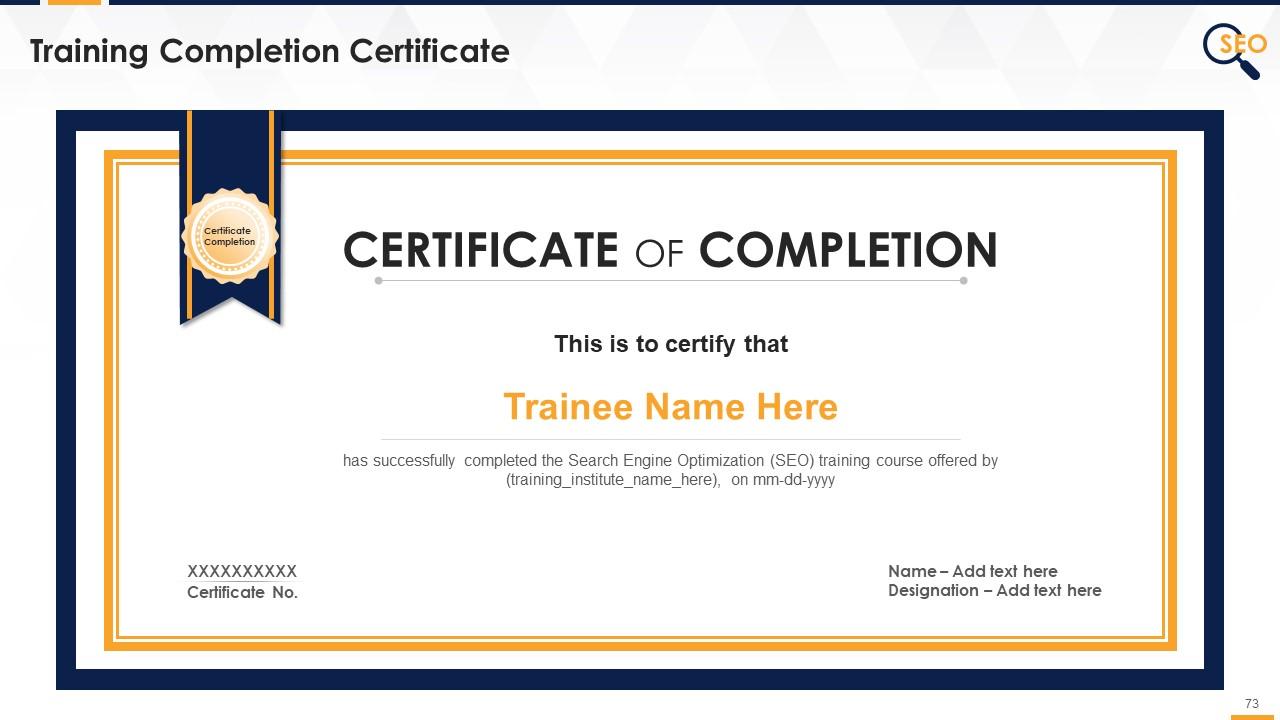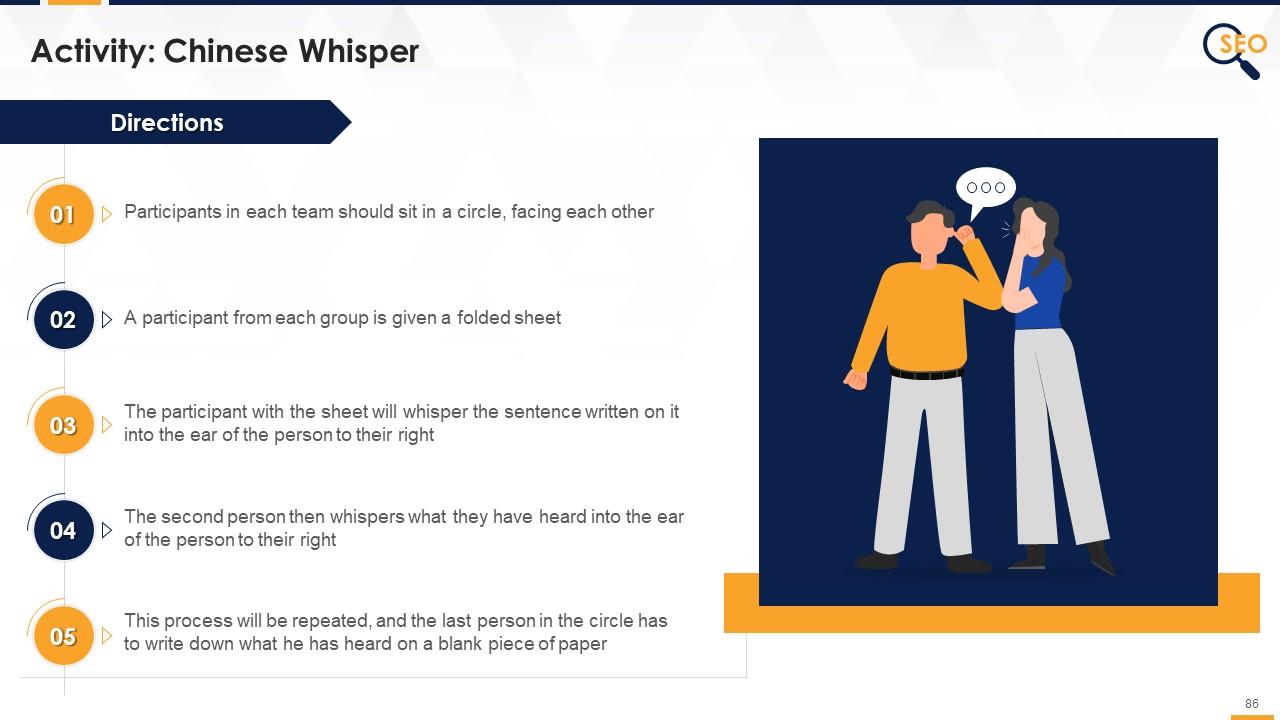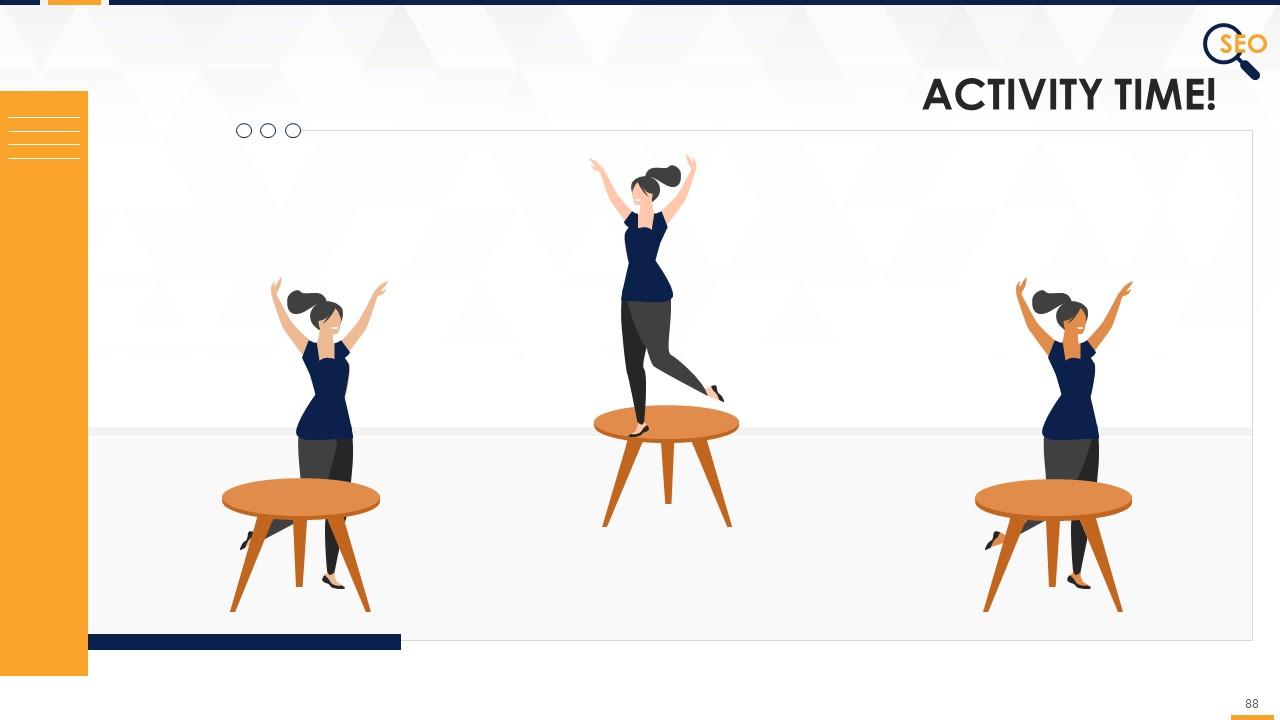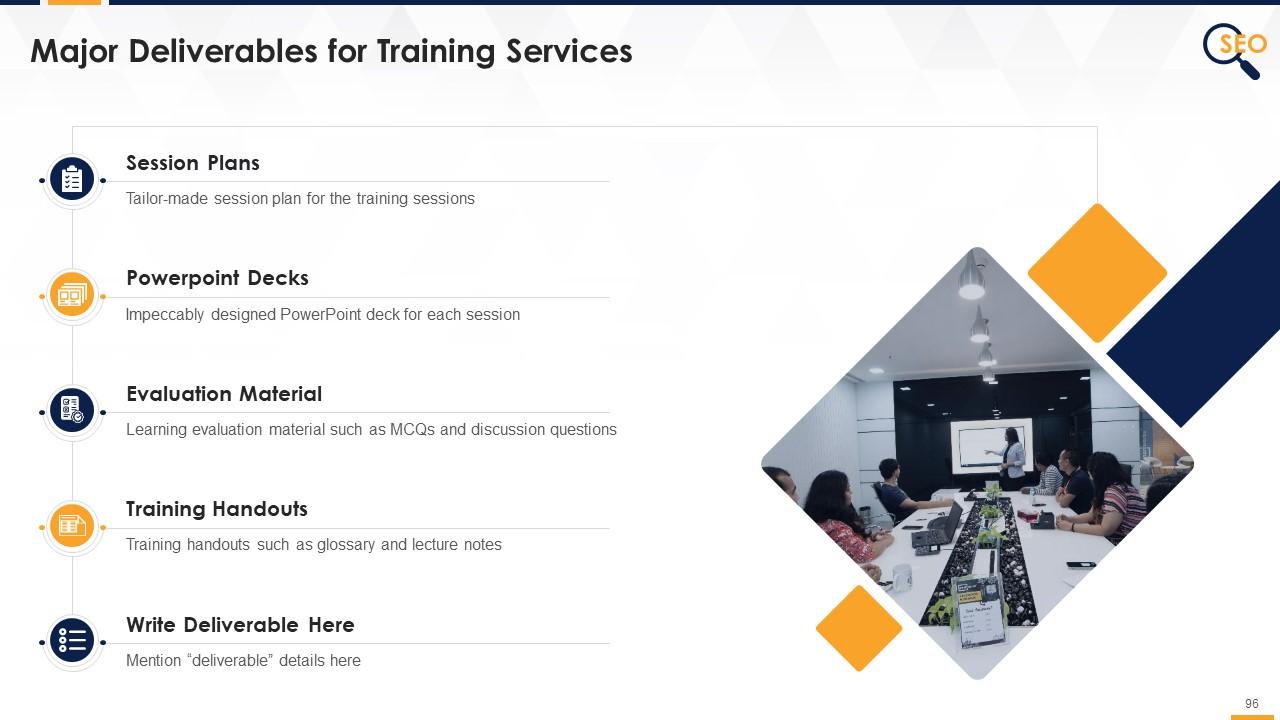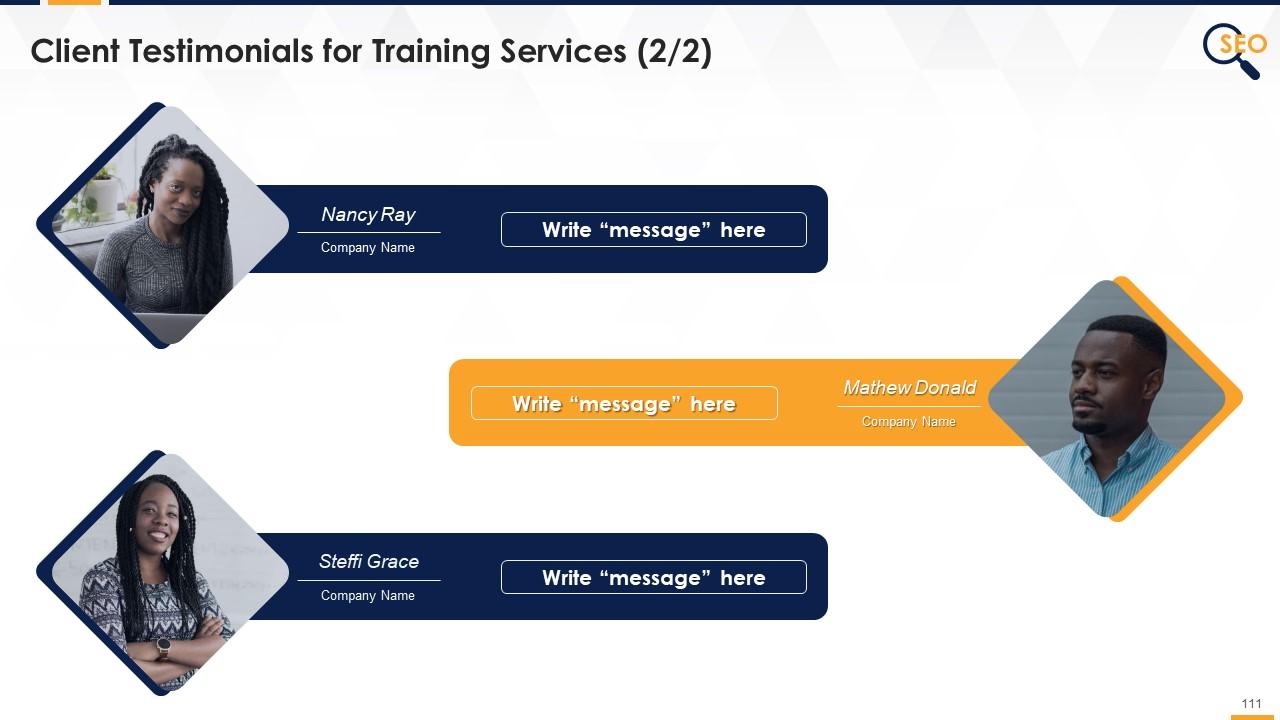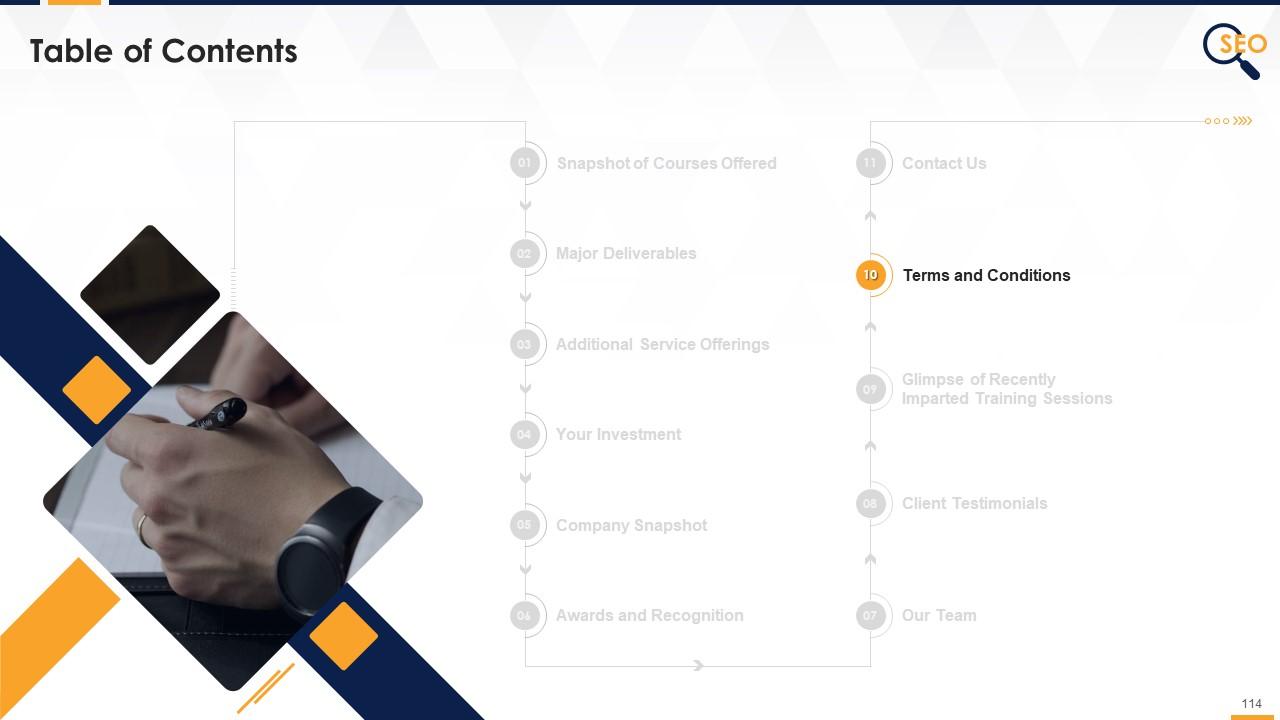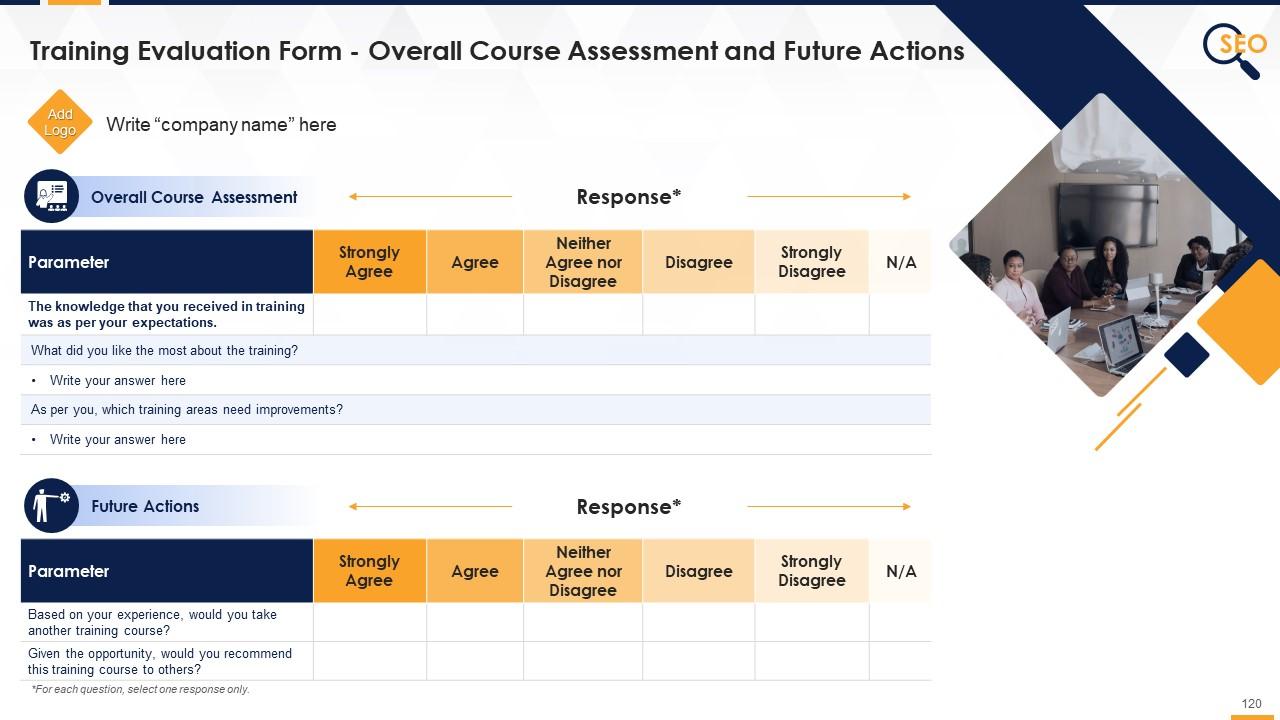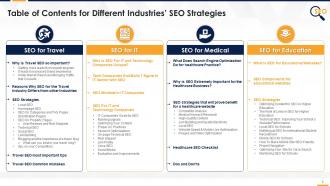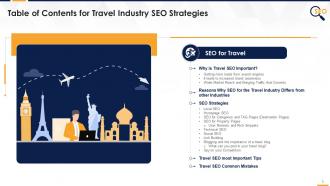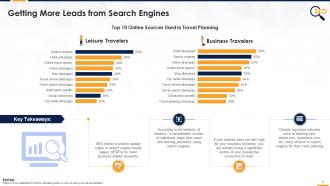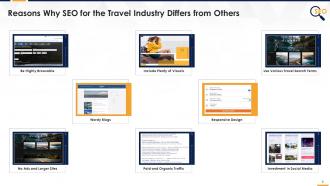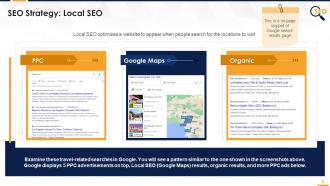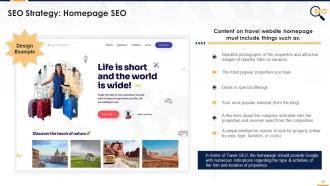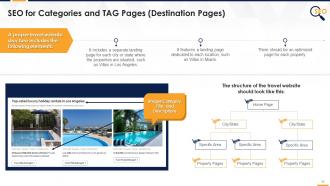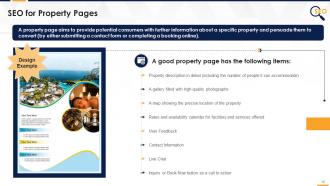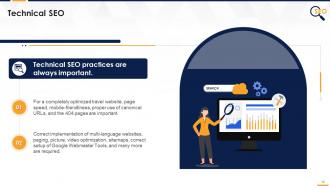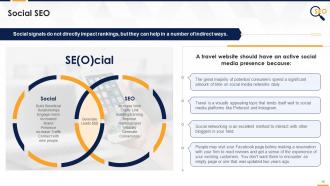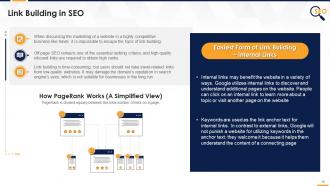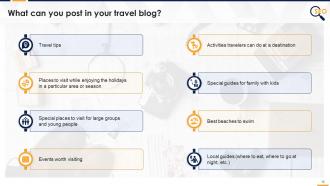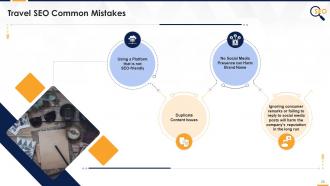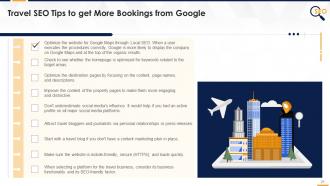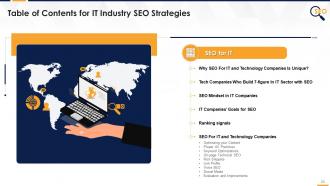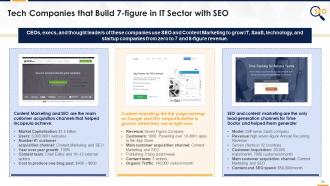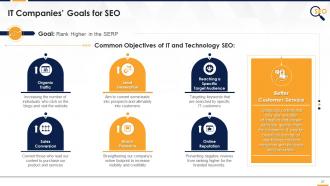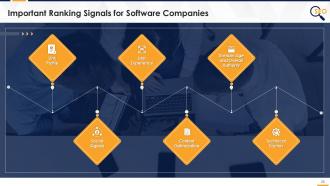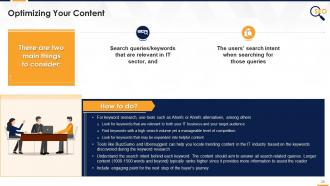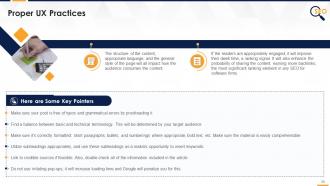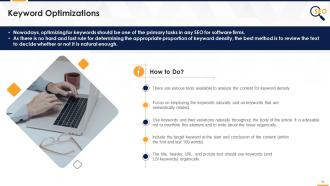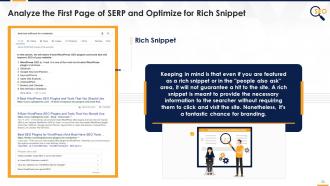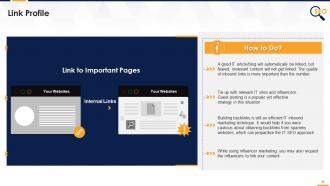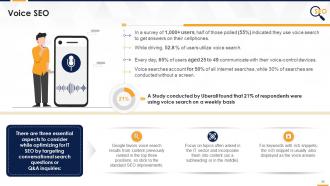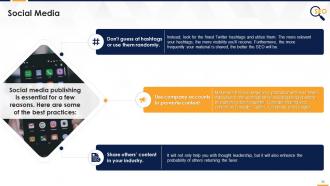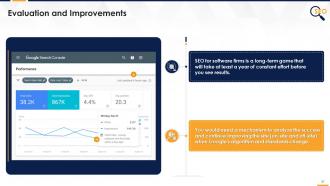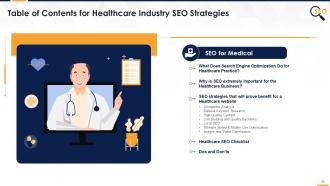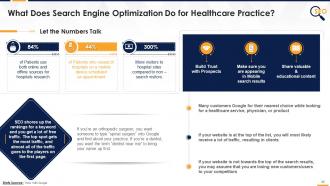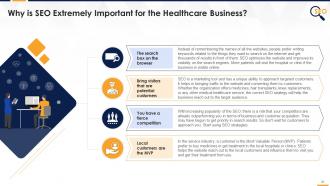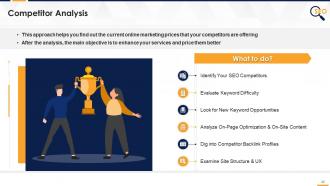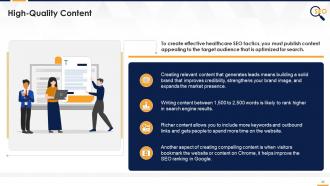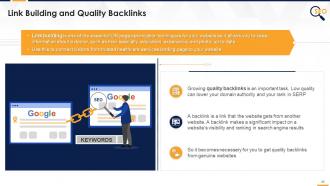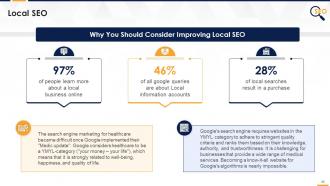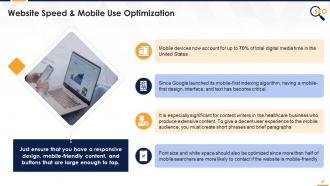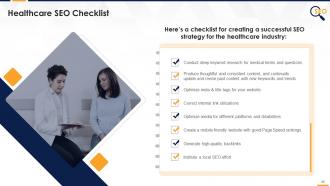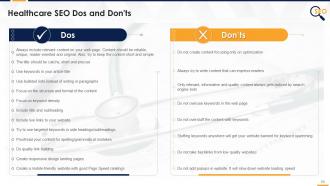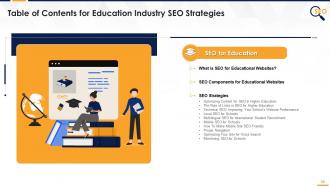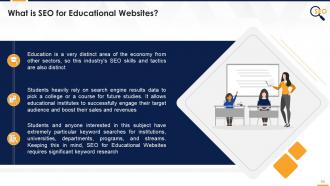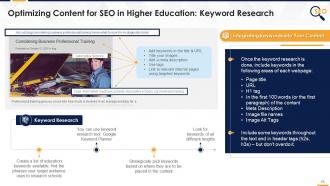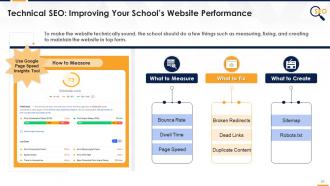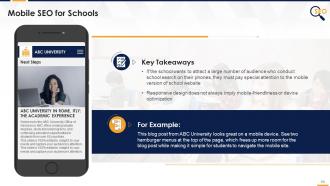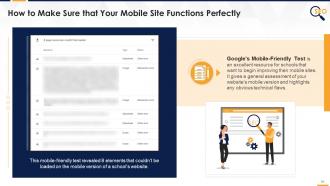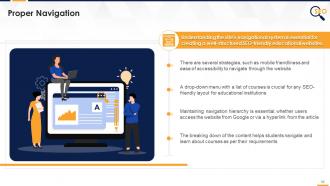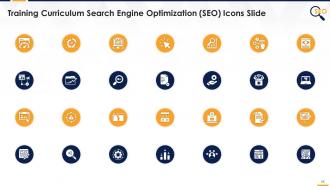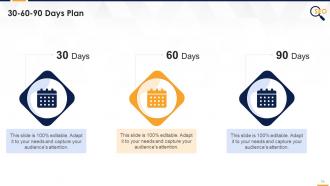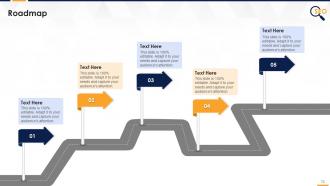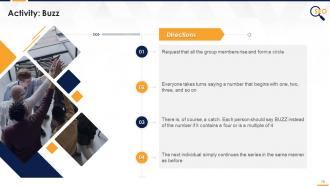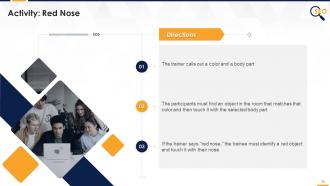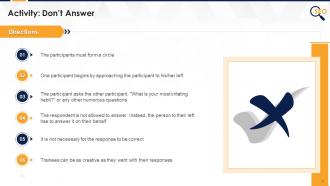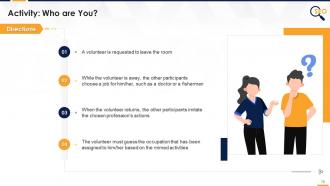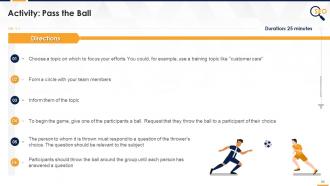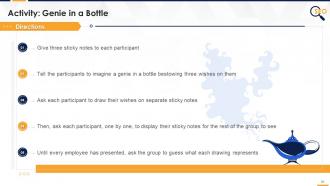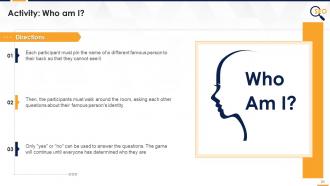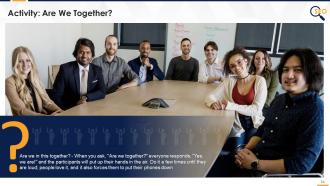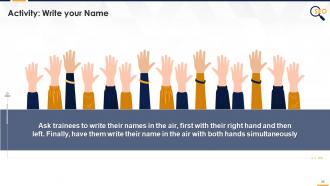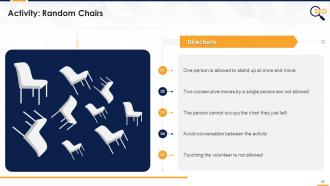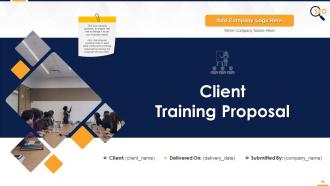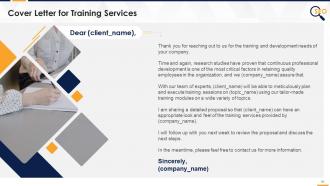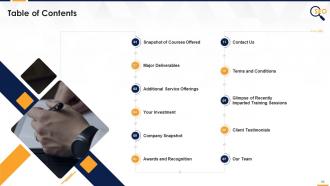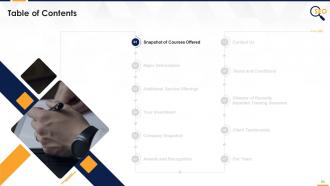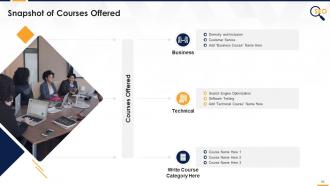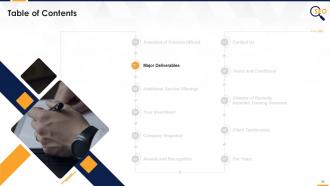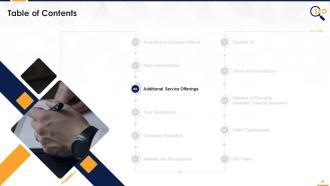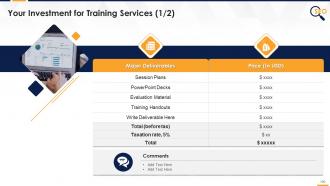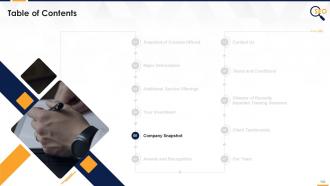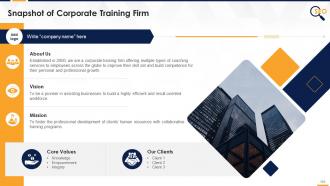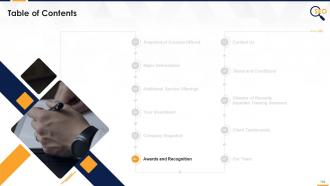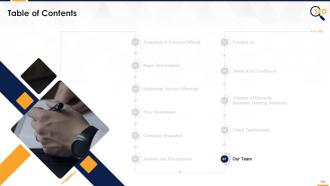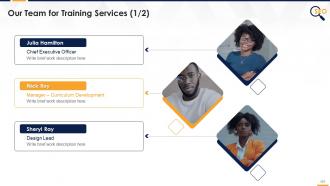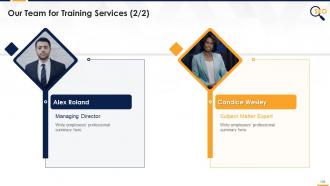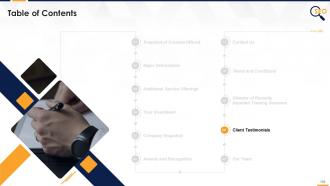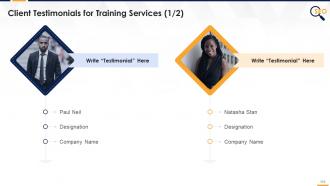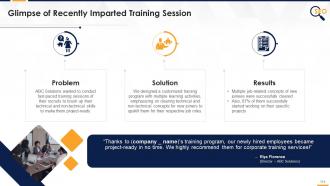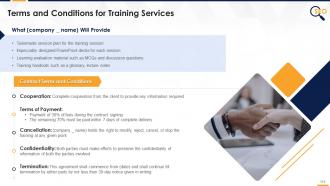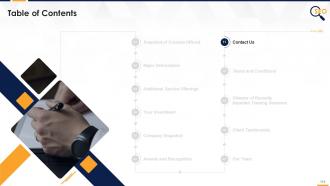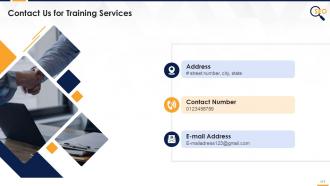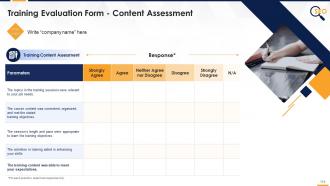SEO Strategies For Different Industries Training Module On Search Engine Optimisation Edu Ppt
This training module covers SEO strategies for different industries. It covers the importance of search engine optimization for travel, IT, medical, and education industries. The SEO strategies for the travel company covered are local SEO, Homepage SEO, SEO for Categories and Tag Pages Destination Pages, User Reviews and Rich Snippets, Travel Blogging, etc. The deck includes the SEO techniques for IT organizations such as Optimizing Content, Keyword Optimizations, Voice SEO, etc. Further, it covers SEO approaches for medical institutes such as Medical Keyword Research, High-Quality Content, Local SEO, Images and Video Optimization, etc. It also includes SEO techniques for educational institutions such as Optimizing Content, Technical SEO, Local SEO, Multilingual SEO, Mobile SEO for schools, etc. The trainers can use this deck to deliver high-impact training with impeccably designed slides using graphics, pictures, illustrations, and other design elements.
You must be logged in to download this presentation.
 Impress your
Impress your audience
Editable
of Time
PowerPoint presentation slides
Presenting Training Module on SEO Strategies for Different Industries. This presentation deck contains 121 well researched and uniquely designed slides. These slides are 100 percent made in PowerPoint and are compatible with all screen types and monitors. They also support Google Slides. Premium Customer Support available. Suitable for use by managers, employees and organizations. These slides are easily customizable. You can edit the color, text, icon and font size to suit your requirements.
People who downloaded this PowerPoint presentation also viewed the following :
Content of this Powerpoint Presentation
Slide 5
This slide covers the importance of SEO in traveling industry. It depicts that SEO generates more leads from search engines despite the presence of big brand traveling websites.
Slide 6
This slide covers the importance of SEO in traveling industry. It depicts that with the help of SEO, a company can get more brand recognition.
Slide 7
This slide covers the importance of SEO in traveling industry. It also depicts that when we use a specific set of keywords on the website, it receives traffic unique that is related to the business.
Instructor's Notes:
Thus, when we use a specific set of keywords on the website, it receives traffic unique to what services a company is offering, so the visitors are more likely to stick on the website.
Slide 8
This slide covers facts and information regarding why SEO for the travel websites is different from other websites.
Instructor's Notes:
Be Highly Browsable:
- When someone is planning a vacation and searching the internet for travel information, they want to go to sites that allow them to feel the experience of their destination. To prepare for their vacation, 69 percent of individuals use online search engines
- Travel websites include background information about numerous things to do and see at the places a person plans to visit
- Blogging for SEO is an excellent strategy used on travel sites that mainly handle bookings or reservations
Include Plenty of Visuals
- Travel websites should also have many pictures
- Travelers want to know where they're headed, and there's no better way to let them know than to show them amazing images
Use Various Travel Search Terms
- When people plan a family vacation, they frequently search for different locations. Visitors will begin by entering in general search phrases such as "affordable family vacation" or terms related to a specific place, such as "where is Costa Rica? “
Wordy Blogs
- Quality vacation websites generally have more than 2000 words per page
- This is because people want a story and virtually experience the vacation before boarding an aircraft. This doesn't mean keyword stuffing should be practiced
- Descriptions of destinations encourage people to experience the same
Responsive Design
- Travelers looking for holiday locations use their smartphones 70% of the time. This demonstrates the significance of having a responsive design for your travel website
- Consumers will switch between tablets, laptops, and smartphones to plan a trip, find destinations, explore its features, book flights, find a hotel, and learn about transportation
No Ads and Larger Sites
- AdSense usage in travel industry is roughly half of other industries. Instead, they focus on travel aggregator sites such as trivago.com. Traveling sites offer more internal links, descriptions of where to go and what to see, and photos to improve the descriptions
Paid and Organic Traffic
- When marketing a travel website, keeping a mix of both organic and paid traffic is the best choice. A research found that when businesses in the travel sector bid on their brand names, it increases clicks by more than 40%
Investment in Social Media
- Marketing done using social media platforms does not affect the Google algorithm but helps boost brand recognition. It should be utilized by travel websites to increase traffic
Slide 9
This slide covers local SEO strategy for travel websites. It also depicts that local SEO optimizes a website to appear when people search for the locations to visit
Instructor's Notes:
In order to get your business listed in the local SEO results, you have to do a number of things like:
- Create a Google My Business account and confirm your company's address.
- Fill out your Google My Business profile with accurate descriptions, contact information, photographs, and other business information
- Include schema information on your homepage
- Include your physical business address on the homepage
- Optimize your page names, h1 tags, and descriptions to include your location
- Obtain high-quality connections from local websites and other well-known websites
- Ensure that the company's name, address, and phone number are consistent across all mediums (Google Maps, your website, local directories, social media pages, etc.)
Slide 10
This slide covers homepage SEO strategy for travel websites/businesses. It also depicts that for travel SEO, the homepage of the website should provide Google with numerous indications regarding the type & activities of the firm and location of properties.
Instructor's Notes:
- If a travel website is presenting numerous vacation homes for rent in Los Angeles, this should reflect in the title of the home page. A decent SEO title may be:
"Exclusive Holiday Villas in Los Angeles" | BrandnameVillas.net.“
- The homepage description is also essential since it may appear in Google results when users search for your site. It should be visually appealing as well as SEO-friendly
Here's an example of an adequate homepage description:
"Stunning Villas for Rent in the most beautiful areas of LA. Browse our collection of exclusive villas and receive discounts on your first booking."
- Make sure to provide schema information on the page such as address and other contact information (as explained in local SEO above)
Slide 11
This slide covers destination pages SEO strategy for travel websites/businesses. It also depicts that there should be a separate landing page for each city or state where the properties are situated.
Instructor's Notes:
- Categories will be the 'City / State' and 'Specific Area' pages
- Have distinct titles, unique content, proper H1 tags, include it in the sitemap. Upload it to Google and highlight the properties accessible in the specific location
- The URL should include the destination e.g.: /villas-in-LA/, for optimum response
Slide 12
This slide covers the property page SEO strategy for travel websites/businesses. It also depicts that website owners should include Breadcrumbs, Unique and informative titles, and proper Page Content, and must not add important content in Tabs.
Instructor's Notes:
In terms of SEO, a property page should include:
Breadcrumbs
- At the top of the page, a breadcrumb allows visitors and search engines to return to the 'Area Pages’ quickly
- For example, the breadcrumb for a property page in Los Angeles should look like this:
Home >> California >> Villas in LA>> Large Villa with Private Pool in Malibu
Unique and informative titles
- This might be difficult, especially if you have a lot of identical properties on the website. While creating the title for a property page, consider the features that set the property apart from the others
- Avoid stating the public place in the title. Instead, be more specific. For example:
Large Villa with Private Pool in Malibu
4 Bedroom Villa in Malibu with direct access to the beach
Page Content
- One of the most frequent issues with travel websites is content duplication when a property is featured on many websites
- Property owners post their homes on many websites to enhance their chances of getting a booking, and they generally use the same information. This may not be a significant deal for large companies like Airbnb, TripAdvisor, or booking.com, but it is a problem for smaller websites
- They should diversify the content as much as possible for SEO and a better user experience. An intelligent method is to convey the property qualities in the form of a tale rather than just giving the facts (which have already been published on other websites)
For example: Once you arrive in the airport, you are only 15 minutes away from a remarkable holiday experience in LA. A 4-bedroom luxury villa is waiting….”
Content in Tabs
- TABS are commonly used in sites to organize categories; however, Google ignores or devalues the content that shows only when users click on the tab and trigger it
- Try not to put essential information in the tabs. You may still utilize them, but keep the most valuable information accessible to Google and users at all times
User Reviews and Rich Snippets
Discussed in detail on next slide
Slide 13
This slide covers user reviews and rich snippets SEO strategy for travel websites/businesses. It also depicts that user reviews and ratings are important features that affect conversions (bookings) in the travel business.
Slide 14
This slide covers technical SEO strategy for travel website/ businesses. It also depicts that for a completely optimized travel website, page speed, mobile-friendliness, proper use of canonical URLs, and the 404 pages are important.
Slide 15
This slide covers social SEO strategy for travel website/ businesses. It also depicts that social signals do not directly impact rankings but they can help in a number of indirect ways.
Instructor's Notes:
Social SEO best practices for travel websites
- Create company pages on the major social media platforms (Facebook, Pinterest, Instagram, and Twitter) and ensure that your social media profiles are SEO optimized
- Create a good fan page for your Facebook business page
- Post on your social media accounts regularly. The articles should not necessarily originate from your website. Still, it should be about travel advice, things to do at your destinations, fascinating facts about your area, and not overly promotional information that people may find intriguing to read and share
- Monitor mentions of your brand across all social networks and make sure you respond to any remarks, excellent or negative
- Keep an eye out for mentions of your locations and try to engage in discussions or answer related queries without being pushy or too commercial
- Set up a monthly budget for Facebook promoted advertisements (either promoting your properties or blog posts)
- Verify that a page posted from your website displays correctly on social media (good photo, title, and description)
Slide 16
This slide covers link building as SEO strategy for travel website/ businesses. It also includes essential factors such as high-quality inbound links, press releases, links from travel review websites and portals, etc.
Instructor's Notes:
How can you get links that matter for your travel website?
- Press releases: One of the few industries where press releases are beneficial is travel. Travel bloggers frequently examine press releases to find offers for exotic destinations for their readers. If you have good deals on the website, your properties may get featured on major travel portals. It is helpful for SEO and provides free PR
- Mentions (links) from travel review websites and portals: In addition to press releases, you may engage with travel bloggers or journalists on Twitter or Facebook and offer them incentives to visit your website
There are many popular travel websites from where you can earn a valuable link to your site, such as:
- The Telegraph Travel
- uk Travel Advice
- The Guardian Travel
- MoneySavingExpert
- Conde Nast Traveller
- Mumsnet Travel Forum
- Lonely Planet
- TripAdvisor
- CNN Travel
- Yahoo Travel
- Forbes
- Huffington Post
Slide 17
This slide covers blogging as SEO strategy for travel website/ businesses. It also covers the importance of having a travel blog on the websites or social media platforms.
Instructor's Notes:
The importance of having a travel blog
- Blogging can provide new content for social media accounts
- It's an excellent technique to create internal links to the property pages
- It's an excellent method to educate your consumers and provide helpful travel information and recommendations
- It's an excellent approach to persuade people to visit your target places by providing videos, photos, and tips on what to do once they arrive, what to see, etc
- It's an excellent way to attract Google bots to revisit and index your new sites frequently
- It's an excellent approach to obtain high-quality connections from other blogs and websites
- It shows the target users that you are not only interested in generating reservations and care about their travel experience, and are doing all in your power to improve it
- It's an intelligent method to earn commission by advertising the services of others
Slide 18
This slide covers list of topics that can be useful to write a travel blog such as travel tips, exotic places to visit, activities travelers can do at destination, events worth visiting, etc.
Slide 19
This slide covers spy on your competitors as an SEO strategy for travel websites/businesses. It also depicts that there are different tools to get a better evaluation of the competitors’ SEO strategies
Slide 20
This slide covers mistakes done in travel SEO such as using a platform that is not SEO-friendly, no social media presence, duplicate content, ignoring consumer reviews, etc.
Slide 21
This slide covers SEO tips and tricks for travel websites/businesses such as optimizing the website for google maps through local SEO, optimize the destination pages by focusing on the content, page names, descriptions, etc.
Slide 24
This slide covers facts and figures on why SEO is crucial in IT and technology companies. It also depicts that social media is one of the effective methods to learn about new companies, and promote IT products and services.
Instructor's Notes:
- Every year, the number of people who use search engines grows at a rapid pace. Every day, approximately 3.5 billion searches are conducted
- Since the early days of the internet, the search engine results page (SERP) has vastly improved. Previously, we could obtain only website results, but now we can get various “rich” and dynamic effects, ranging from featured snippets to linked Google Maps results
- Search engines, notably Google, have become an integral part of our daily life. It is currently, aside from social media, one of our primary sources of information. It is also one of the effective methods to learn about new companies, goods, and services
Slide 25
This slide covers tech companies that build 7-figure in IT sector with SEO. It also depicts that content marketing and SEO are the main customer acquisition channels.
Slide 26
This slide covers problem regarding SEO Mindset in IT Companies along with its solutions. It also depicts that the role of SEO is to align the online presence, including our website, content, and even social media presence, according to the guidelines of Google and other search engines.
Slide 27
This slide covers the goals of IT companies for doing SEO such as increasing organic traffic, leads, sales conversion, online reputation, brand presence, defining target market, better customer service, etc.
Instructor's Notes:
No matter the strategy or tactic you choose, the core of any SEO tactic for technology and IT companies will revolve around the target keywords.
Slide 28
This slide covers ranking signals for IT/SaaS or software companies such as social signals, content optimization, link profile, technical factors, domain age and overall authority, user experience, etc.
Instructor's Notes:
Three major technical parameters are especially crucial for SEO:
- A secure and trustworthy site (including HTTPS utilization),
- Mobile responsiveness, and
- Optimal site load speed
This is a very basic and rather very crucial step.
Google will not rank the site if it is not viewed as secure. If the site has a lot of risks because it is difficult to load, it may not rank, and the IT SEO efforts will be futile.
- More than 55% of the sites listed in the top ten positions on Google SERPs are at least three years old
- If your site is relatively new, there isn't much you can do about it besides buying an old domain and making it your own
- Boost your authority by maximizing other ranking factors, including having more high-quality backlinks
- Use semantically-related keywords for content optimization
There are three main user experience metrics to focus on while optimizing SEO for your IT website:
- CTR (Click-through Rate): the number of individuals that clicked on your link when it showed in the search results
- Bounce Rate: the percentage of visitors that leave your site after only a few seconds. Google will interpret this as your site being unrelated to the search query
- Dwell Time: the amount of Time a person spends on your site after visiting it. It is frequently linked to the relevance and quality of your material
Link profile: when a site links to your site, Google will perceive your site as more relevant.
Social Signals: getting more social shares can significantly help in improving your ranking.
Slide 29
This slide covers factors considered while optimizing content in IT sector such as search queries/keywords that are relevant in IT sector, and the user’s search intent when searching for those queries.
Slide 30
This slide covers optimizing UX/UI as SEO strategy for IT/ SaaS or software companies. It also depicts that if the readers are appropriately engaged, it will improve their delay time, a ranking signal, and the probability of sharing the content, earning more backlinks, etc.
Slide 31
This slide covers keywords optimization as SEO strategy for IT/ SaaS or software companies. It also covers the ways to do it such as keeping keywords and their variations naturally throughout the body of the article, etc.
Slide 32
This slide covers the on-page technical SEO strategy for IT/ SaaS or software companies. It also cover how to do it such as improve the site's user experience, including mobile responsiveness, quick loading time, and other elements that will keep the audience on the site for longer duration.
Instructor's Notes:
Checklist for technical SEO optimization for IT
- Update your page experience – core metrics
- Crawl your site and look for any crawl errors
- Fix broken internal and outbound links
- Get rid of any duplicate or thin content
- Migrate your site to HTTPS protocol
- Make sure your URLs have a clean structure
Slide 33
This slide covers optimizing rich snippet as SEO strategy for IT/ SaaS or software companies. It also depicts that rich snippets are a fantastic chance for branding IT products.
Instructor's Notes:
- If being highlighted as a rich snippet may help you reach business goals, go for it. For example, if you are an IT Service firm, landing on the first three pages of Google SERPs using SEO services (together with a rich snippet for software developer inquiries) may dramatically boost conversion rate
- Keyword research tools can assist you in analyzing keywords with a high organic click-through rate (CTR). In most situations, these are terms that did not receive feature-rich snippets as a consequence, but there are certain instances when organic CTR stays high even when featured snippets are present. Such keywords should be considered
- A rich snippet must be included in the keyword itself. Keywords with rich snippets potential can be identified using tools such as Ahrefs
- More than 99.5 % of rich snippets come from pages already on the first page of search results for the term
- The page is correctly constructed using structured data markups, which effectively provide attributes and properties to all of your page's elements
Slide 34
This slide covers link profile as SEO strategy for IT/ SaaS or software companies. It also depicts the ways to do it such as guest posting, influencer marketing, SaaS inbound marketing, etc.
Instructor's Notes:
Promote Your Content to Earn Backlinks
For IT companies, tactics that are effective include:
- Digital PR
- Resource link building
- Unlinked brand mentions
- Broken link building
- Guest posting
Slide 35
This slide covers voice SEO strategy for IT/ SaaS or software companies. It also depicts that there are three essential aspects to consider when optimizing for SaaS by targeting conversational search questions or Q&A inquiries:
Instructor's Notes:
- Google favors voice search results from material previously ranked in the top three positions, so stick to the standard SEO optimizations.
- For keywords with rich snippets, the rich snippet is usually also displayed as the voice answer.
- Focus on topics often asked in the IT service sector and incorporated them into the content (as a subheading or in the middle of the content).
Attempt to outperform the competition by answering the questions better and being included as a rich snippet.
Slide 36
This slide covers social media publishing as SEO strategy for IT industry. It also depicts that a business should use company accounts to promote content, share others’ content in your industry, etc.
Slide 37
This slide covers evaluation and improvements strategy for IT/ SaaS or software companies. It also depicts that SEO for IT companies is long term and includes ways to improve the performance.
Instructor's Notes:
How to do it?
- Create a Google Search Console account, then let it examine your site and correct any issues. It should be checked frequently.
- When Google's algorithm changes, pay close attention. In general, if you monitor SEO and digital marketing issues, you will be aware of any significant changes.
- There is no such thing as really evergreen material; there is always scope for improvement, so constantly update content with new data and facts. You may also wish to modify the content if it isn't doing well.
- Keep a careful eye on your competitors' link profiles, fresh content, and general SEO strategy. Keep in mind that SEO is a competition, and strive to be at the top constantly.
Slide 40
This slide covers details on what SEO does for healthcare practice. It depicts that SEO shores up the rankings for a keyword and you get a lot of free traffic. The top spot gets the most traffic, and almost all of the traffic goes to the players on the first page.
Instructor's Notes:
What’s involved in healthcare SEO.
- Setting up your local listings in Google My Business, Bing Places, and Yahoo Local
- Wisely-targeted, natural keyword usage
- An optimized URL for individual pages
- Earning backlinks from other sites
- Creating quality content consistently
- Ensuring backend things like title tags and image tags are optimized as well
Slide 41
This slide covers details on why SEO is important for the healthcare businesses. There are reasons such as the search box on the browser brings visitors that are potential customers, growing competition, and local SEO.
Slide 42
This slide covers competitor analysis as SEO strategy for healthcare industry. It also depicts that this research will assist businesses in better identifying opportunities and preparing for potential threats
Instructor's Notes:
- A competitor analysis will evaluate the strengths and weaknesses of your competitors
- The results of this research will assist you in better identifying opportunities and preparing for potential threats
- Use the findings of this analysis to develop practical goals, like enhancing the website's user interface, adjusting the scheduling of campaigns to better match with peak search hours, or developing keyword-rich content to answer popular search questions
Slide 43
This slide covers medical keyword research as SEO strategy for healthcare industry. It also depicts that businesses should evaluate and improve upon their competitors' internet marketing techniques.
Instructor's Notes:
Consider the following metrics to have a better idea of the average number of times a term is searched and the number of clicks it receives from potential customers:
- Search volume (starting from 1K)
- Keyword difficulty
- Cost-per-click (CPC)
- Clicks volume
Steps for Keyword Research
- Your own insights
- Google related search results and ‘smart’ search results or ‘featured snippets’
- See what other people are talking about in comments
- Wikipedia page
Slide 44
This slide covers creating high-quality content as SEO strategy for healthcare industry. It also depicts that creating relevant content that generates leads means building a solid brand that improves credibility, strengthens your brand image, and expands the market presence.
Instructor's Notes:
Write new and update old content based on keywords
By continuously improving your content, you may leverage SEO for physicians, medical practices, or digital health goods in three ways:
1. Only write things that matter. If your content solves your readers’ inquiries while being SEO-friendly, it will beat your competitors’ content
2. Update your old content. Update and revise your blog posts at least every six months following new keywords and trends
3. Make content update a cycle, not a single activity. Search engines love when content is regularly updated, resulting in better rankings
Slide 45
This slide covers link building and quality backlinks as SEO strategy for healthcare industry. It also depicts that getting quality backlinks is an important task as low-quality links can lower the domain authority and website rank in SERP.
Instructor's Notes:
Backlinks are the inverse of internal links since they connect pages to other domains. For instance, if Wikipedia links to your website, then you have a Wikipedia backlink.
Link building helps you to:
- Improve your rankings because Google considers backlinks to be votes of confidence
- Increase the discoverability of your website because crawlers love to revisit popular pages
- Drive referral traffic by directing readers to your website and projecting you as a subject matter expert
To make the most of your backlinks, consider the following steps:
- Include your website with free healthcare listings and ratings
- Republish your content on additional platforms like as ClinicAll, Healthcare in America, and Tincture
- Submit your articles or op-eds to local healthcare authorities, including digital publications, newsletters, and blogs
Slide 46
This slide covers as local SEO strategy for healthcare industry. It also depicts that Google's search engine requires websites in the YMYL category to adhere to stringent quality criteria and ranks them based on their knowledge, authority, and trustworthiness.
Instructor's Notes:
Nearly half of all Google searches are local services. Furthermore, many healthcare companies fail to claim their Google My Business (GMB) page.
It enables landing pages or out-of-date websites to continue receiving traffic from potential customers. Consider the following questions as a fast way to fine-tune your GMB section:
- What are our keywords? Why do they send us the most traffic? What is the search volume for our most important keywords?
- What queries did our consumers look up this month on Google? Can we provide clear answers in our Q&A section?
- How soon do we respond to comments on our local page? Can we make this procedure better?
Slide 47
This slide covers website speed & mobile use optimization as SEO strategy for healthcare industry. It depicts that websites should ensure that they have a responsive design, mobile-friendly content, and buttons that are large enough to tap.
Slide 48
This slide covers image and video optimization as SEO strategy for healthcare industry. It also depicts that use of "Alt" tags improves the accessibility of the website and its topic relevancy.
Instructor's Notes:
Google's search ranking guidelines state that content should be optimized for humans rather than robot crawlers. However, by including additional information about the media you post, search results may become far more relevant, resulting in higher-quality traffic to your website.
Slide 49
This slide covers healthcare SEO strategy checklist. It includes optimization of meta & title tags, correct internal link utilizations, optimization of media, generating high-quality backlinks, etc.
Slide 50
This slide covers do’s and don’ts of the healthcare SEO such as creating landing pages with responsive design, optimizing for mobile, not taking backlinks from low quality websites, etc.
Slide 53
This slide covers what SEO means for Education industry and why it is different from other industries. It also depicts that educational websites require particular keyword searches for different institutions.
Slide 54
This slide covers SEO techniques for schools, institutions, universities, departments, programs, and streams such as use of visual elements, keywords integration, domain age, fresh content & frequency, content indexing, quality, length, and mobile optimization
Instructor's Notes:
- Image Use: Using engaging visual components on educational websites, like video and pictures, will improve your search results dramatically
- Keyword Integration: Organically including relevant education field keywords in the online content enhances the pages' likelihood of being found in relevant course searches
- Page and domain authority: As more people visit the educational website and web pages, the online reputation improves, and the domain authority rises
- Freshness and Frequency of content: The quicker you generate stuff and the more fresh educational content you have, the better you will rank
- Page Architecture: Each search engine has its indexing system, and crawlers are used to assess the composition of the content. It is critical to include components such as page titles and header tags (H1s, H2s, etc) on the educational website to demonstrate to these crawlers that your content is well-structured
- Content Quality: During the optimization process, don't lose sight of the audience. Make an effort to generate high-quality content that the prospects will find entertaining and valuable
- Content Length: With an average length of 1,890 words for a top-ranked article on Google, search engines prefer lengthier content. Long-form blogs are an excellent method for schools to incorporate more lengthy content into their overall SEO plan
- Mobile-Friendliness: If the site isn't mobile-friendly, the search rating will suffer
Slide 55
This slide covers content optimization as SEO strategy for education industry. It also depicts keywords that should be included in page title, URL, H1 tag, in first paragraph of the content meta description, image files, and alt tags.
Instructor's Notes:
Keyword Research: look for keywords of all different lengths
- One to two-word phrases with a high search volume are best for headers; select some shorter, more generic keywords
- Body keywords are often two to three-word phrases with a medium search volume
- Long tail keywords — phrases with more than four words have a low search volume, are less competitive, and produce a lot of web traffic
Additional Content Optimization Tips
There are a few additional strategies to boost your school's search ranking by creating content
- Shorter URLs are preferable to longer URLs when it comes to search algorithms
- Try to incorporate as few words as possible beyond the keyword in your URLs while still distinguishing each page
- You may do this by removing short, non-descriptive terms like "the" or "an"
Optimize multimedia content, such as video to boost the school's search ranking.
Use the following strategies to optimize video content for SEO:
- Inserting metadata such as titles, descriptions, file names, schema tags, and thumbnails.
- Creating one-of-a-kind webpages for the videos
- Optimizing for YouTube by adding tags and actively attempting to increase interaction on the videos
- Inviting prospects to subscribe, directing visitors to your website, and more
- Incorporate transcripts and closed captions into your videos
Slide 56
This slide covers link building as SEO strategy for education industry. It also depicts that the more links one website gets from another, the higher will be the search engine ranking and better page & domain authority, and ranking power for linked pages.
Instructor's Notes:
Internal linking has three main functions:
- To help navigate around the website
- To display the website’s design
- To distribute page authority and ranking power
Why is it important to use links?
As website visitors consume the content on the school's webpages, you may continue to feed them links to topics that may be of interest to them. It will keep them on the website for a more extended period. The longer people remain, the better it is for the school website.
- It is also critical to include external links in the article. These links explain to search engines that the material has been thoroughly researched and deserves a spot on Google's first page.
- Don't just link to any old website; instead, make sure the external links take readers to popular, authoritative websites. If you direct users to untrustworthy websites, Google may penalize the school.
How will it benefit the school website?
- The use of links is another essential component of creating domain authority
- When people connect to the school's website, Google recognizes that it contains information worth linking to. The same logic applies to internal linking. When you link to other pages on the website, Google considers this as a "vote" or a sign of support for the content
- The more content gets linked to, the more votes it receives, thus ranking better in search engines. Adding internal links to the content, in other words, can boost the number of votes your page receives
Slide 57
This slide covers optimizing website performance as technical SEO strategy for education industry. Technical SEO tells what to measure, i.e., bounce rate, dwell time, page speed; and what to fix, i.e. broken redirects, dead links, and duplicate content; and what to create, i.e. sitemap & robots.txt file.
Instructor's Notes:
The school must strive to make its website as organized and glitch-free as possible. By improving technical SEO, increase search ranking, and provide prospects with a better user experience.
What to Measure
- Bounce rate: The number of users that left your website without taking any further action after reading a single page
- Dwell time: The time visitors spend on the website. As you may expect, the longer the dwell time, the better
- Page speed: It refers to how quickly the website loads. To evaluate the effectiveness of this SEO element, utilize the Page Speed Insights tools to measure. If you get a poor score, you might rework on the website design or condense the photos
What to Fix
Some technical issues can hurt the site's search ranking, so it's essential to mitigate these factors as much as possible:
- Dead links: It directs users to a nonexistent page. If something irritates the visitors, it reduces your technical SEO score
- Broken redirects: These send users to a resource that may no longer exist
- Duplicate content: refers to pages containing identical or highly similar content because it is virtually hard for search engines to decide which pages to display in search results. So often, none are shown
What to Create
- Consider establishing a sitemap and robots.txt files to make it easy for search engines to analyze the site's structure
- A sitemap is just a file that lists all of the website's URLs and is used by search engines to index the website. A robot.txt file, on the other hand, comprises the sites that you don't want to get indexed or show in search, such as particular policy pages
- By generating these files, the school can prove to search engines that its website is well-organized and, as a result, easy to browse for visitors
Slide 58
This slide covers local SEO technique as SEO strategy for education industry. Local SEO for schools include keywords optimization and NAP (name, address, and phone number) strategies.
Instructor's Notes:
Many people can call your company/school ‘HEA’, Google prefers full names as it’s easier for them to differentiate you from another unrelated business that goes by the same name.
Slide 59
This slide covers multilingual SEO technique for international student recruitment in education industry. It also depicts that translating from original website is good but search engine will give extra rewards if businesses will generate fresh, unique content for the second language page.
Slide 60
This slide covers mobile SEO technique for education industry.
Slide 61
This slide covers details on how to make mobile SEO-friendly for education industry. It also lists the methods for ensuring that your mobile site complies with search engine requirements.
Instructor's Notes:
Manually update the mobile site to improve user experience to increase mobile SEO.
Here are some methods for ensuring that your mobile site complies with search engine requirements:
- Images should be scaled for mobile users
- With only 4-8 pages, create clickable, easy-to-view navigation
- Use a hamburger menu if you need additional options
- Avoid Pop-ups
- Reduce copy above the fold
- Make your own mobile CTAs
Slide 62
This slide covers proper navigation on school website as SEO strategy for education industry. It also depicts that understanding the site's navigational system is essential for well-structured website.
Instructor's Notes:
For example: Suppose a student is looking for a bachelor's degree in chemistry. They will be given a list of institutions ranked according to their preferences. They wish to take the application process and cut-off marks once they've decided on a specific university domain. The student's search will be more straightforward if the site contains easy-to-find specific links for admission procedures, online applications, needed documents, etc.
Slide 63
This slide covers optimizing school website for voice search as SEO strategy for education industry. It also depicts that school website should include 29-words answer for school-related questions in the blog posts, which will optimize the website for voice search.
Instructor's Notes:
- A featured snippet is a brief response to a user's query that appears at the top of Google's search results. When someone does a verbal search, this is the only result that is read back to them - therefore, schools should work hard to get their site in this 'zero' position for relevant searches
Slide 64
This slide covers monitoring SEO for school as strategy for education industry. It also depicts that education businesses must monitor their website through KPI/metrics such as loading speed, your website’s mobile-friendliness, etc.
Instructor's Notes:
- Search engine optimization isn’t a one-time thing. It’s a lifetime project. As search algorithms change with new online trends and user activities, so your website is never optimized
- With this aspect, SEO strategy for higher education must include monitoring the website’s search rankings
- Keep a check-up on your site to identify pitfalls and ensure that everything performs how you’d like it to be
- Regularly perform some of the tests mentioned above to assess your site loading speed, your website’s mobile-friendliness, and more
Slides 75 to 90
These slides include multiple energizer activities to break the monotony of training sessions and actively engage trainees. The energizer activities are as follows:
- Buzz
- Red Nose
- Don’t Answer
- Who are You?
- The Name Game
- Pass the Ball
- Genie in a Bottle
- Names and Adjectives
- Who am I?
- Are We Together?
- Write your Name
- Chinese Whisper
- Random Chairs
Slide 92
This slide highlights the cover letter for the training proposal. It includes details regarding what the company providing corporate training can accomplish for the client.
Slide 95
The purpose of this slide is to showcase the multiple types of courses offered by the training company.
Slide 97
This slide indicates the major deliverables that the corporate training firm will provide to the client. The key deliverables highlighted are session plans, PowerPoint deck, evaluation material, and training handouts.
Slide 99
This slide represents the multiple additional services offered by the training firm to the client, such as webinars, planning journals, and e-learning design solutions.
Slide 101
This slide tabulates the major deliverables offered by the training company to the client along with their associated costs.
Slide 102
The purpose of this slide is to highlight the multiple additional services offered by the training firm along with their cost details.
Slide 104
This slide provides an overview of the corporate training firm's vision and mission statements, core values, and key clients.
Slide 106
This slide highlights the major awards and recognition won by the training firm for their exceptional service to clients.
Slide 108
The slide provides information regarding the team members that would be providing the training services to the client. It includes details of the trainer and their respective designations.
Slide 109
The slide provides information regarding the team members that would be providing the training services to the client. It includes details of the employees names and their respective designations.
Slide 111
This slide provides information pertaining to testimonials given by satisfied clients of the training firm.
Slide 112
This slide highlights the testimonials from multiple satisfied clients of the training firm providing information regarding congratulatory messages, client name, and company details.
Slide 114
This slide showcases the case study for the training proposal. It includes information regarding the problem faced by the client and solutions offered by the training firm. It also covers details of the results and client testimonial.
Slide 116
This slide provides information regarding the contract terms and conditions of the training proposal. It also includes details of deliverables that the training company will provide to the client.
Slide 118
The purpose of this slide is to provide the contact information of the corporate training firm. It includes the firm’s official address, contact number, and email address.
Slide 119
This slide highlights the training evaluation form for instructor assessment. It also includes sections to fill details of training information and attendee details.
Slide 120
This slide showcases the questions for the assessment of the training content by the attendees.
Slide 121
The slide indicates the evaluation form for course assessment. It also includes questions pertaining to the future actions of the attendees.
SEO Strategies For Different Industries Training Module On Search Engine Optimisation Edu Ppt with all 125 slides:
Use our Training Module On Search Engine Optimization SEO Strategies For Different Industries Edu Ppt to effectively help you save your valuable time. They are readymade to fit into any presentation structure.
-
Colors used are bright and distinctive.
-
The content is very helpful from business point of view.



